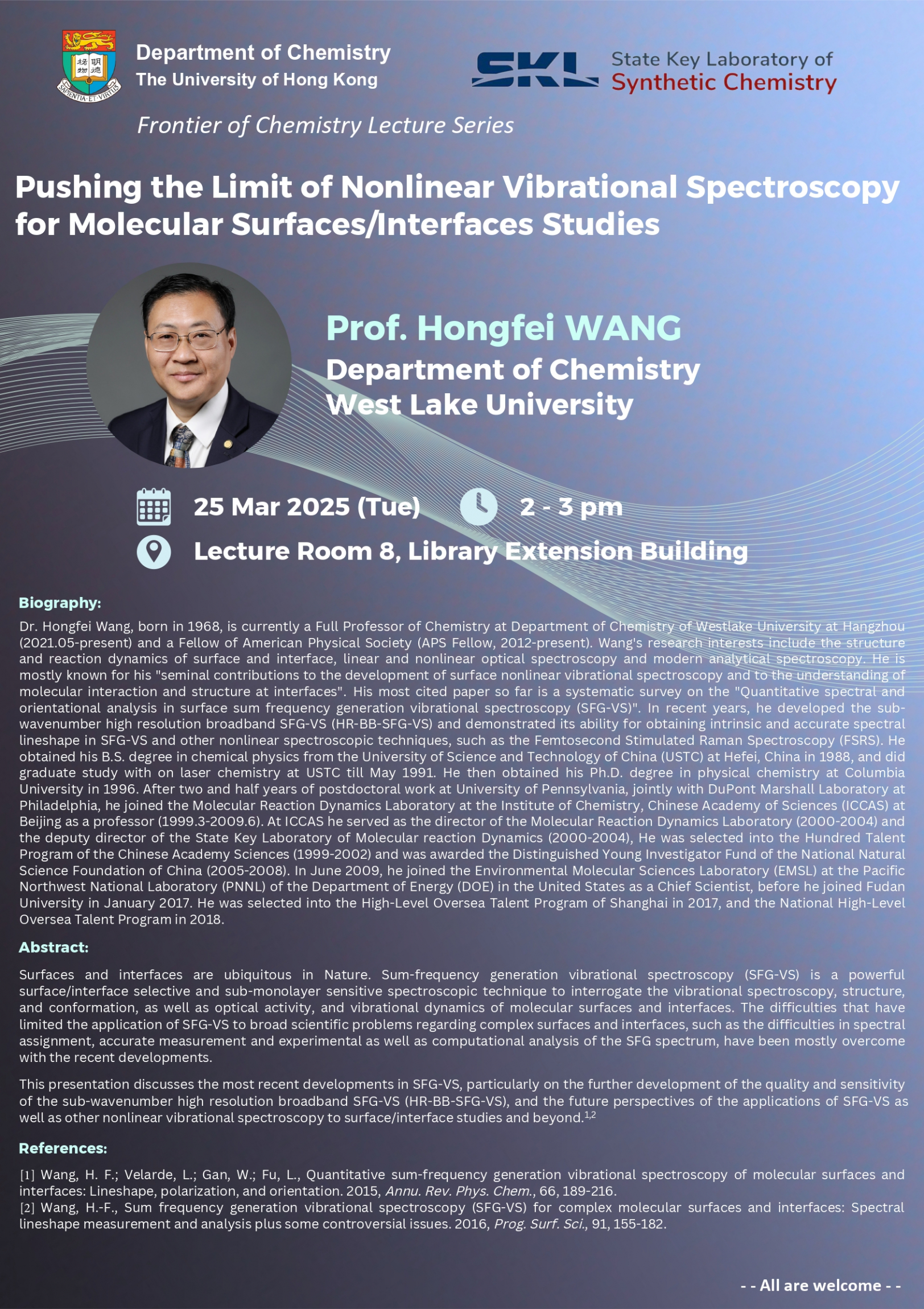| Date | 25 Mar 2025 |
| Time | 2:00 pm - 3:00 pm (HKT) |
| Venue | Lecture Room 8, Library Extension Building |
| Speaker | Prof. Hongfei WANG |
| Institution | Department of Chemistry, West Lake University |

Title:
Pushing the Limit of Nonlinear Vibrational Spectroscopy for Molecular Surfaces/Interfaces Studies
Schedule:
Date: 25th February, 2025 (Tuesday)
Time: 2 - 3 pm (HKT)
Venue: Lecture Room 8, Library Extension Building
Speaker:
Prof. Hongfei WANG
Department of Chemistry
West Lake University
Biography:
Dr. Hongfei Wang, born in 1968, is currently a Full Professor of Chemistry at Department of Chemistry of Westlake University at Hangzhou (2021.05-present) and a Fellow of American Physical Society (APS Fellow, 2012-present). Wang's research interests include the structure and reaction dynamics of surface and interface, linear and nonlinear optical spectroscopy and modern analytical spectroscopy. He is mostly known for his "seminal contributions to the development of surface nonlinear vibrational spectroscopy and to the understanding of molecular interaction and structure at interfaces". His most cited paper so far is a systematic survey on the "Quantitative spectral and orientational analysis in surface sum frequency generation vibrational spectroscopy (SFG-VS)". In recent years, he developed the sub-wavenumber high resolution broadband SFG-VS (HR-BB-SFG-VS) and demonstrated its ability for obtaining intrinsic and accurate spectral lineshape in SFG-VS and other nonlinear spectroscopic techniques, such as the Femtosecond Stimulated Raman Spectroscopy (FSRS). He obtained his B.S. degree in chemical physics from the University of Science and Technology of China (USTC) at Hefei, China in 1988, and did graduate study with on laser chemistry at USTC till May 1991. He then obtained his Ph.D. degree in physical chemistry at Columbia University in 1996. After two and half years of postdoctoral work at University of Pennsylvania, jointly with DuPont Marshall Laboratory at Philadelphia, he joined the Molecular Reaction Dynamics Laboratory at the Institute of Chemistry, Chinese Academy of Sciences (ICCAS) at Beijing as a professor (1999.3-2009.6). At ICCAS he served as the director of the Molecular Reaction Dynamics Laboratory (2000-2004) and the deputy director of the State Key Laboratory of Molecular reaction Dynamics (2000-2004), He was selected into the Hundred Talent Program of the Chinese Academy Sciences (1999-2002) and was awarded the Distinguished Young Investigator Fund of the National Natural Science Foundation of China (2005-2008). In June 2009, he joined the Environmental Molecular Sciences Laboratory (EMSL) at the Pacific Northwest National Laboratory (PNNL) of the Department of Energy (DOE) in the United States as a Chief Scientist, before he joined Fudan University in January 2017. He was selected into the High-Level Oversea Talent Program of Shanghai in 2017, and the National High-Level Oversea Talent Program in 2018.
Abstract:
Surfaces and interfaces are ubiquitous in Nature. Sum-frequency generation vibrational spectroscopy (SFG-VS) is a powerful surface/interface selective and sub-monolayer sensitive spectroscopic technique to interrogate the vibrational spectroscopy, structure, and conformation, as well as optical activity, and vibrational dynamics of molecular surfaces and interfaces. The difficulties that have limited the application of SFG-VS to broad scientific problems regarding complex surfaces and interfaces, such as the difficulties in spectral assignment, accurate measurement and experimental as well as computational analysis of the SFG spectrum, have been mostly overcome with the recent developments.
This presentation discusses the most recent developments in SFG-VS, particularly on the further development of the quality and sensitivity of the sub-wavenumber high resolution broadband SFG-VS (HR-BB-SFG-VS), and the future perspectives of the applications of SFG-VS as well as other nonlinear vibrational spectroscopy to surface/interface studies and beyond.1,2
References:
[1] Wang, H. F.; Velarde, L.; Gan, W.; Fu, L., Quantitative sum-frequency generation vibrational spectroscopy of molecular surfaces and interfaces: Lineshape, polarization, and orientation. 2015, Annu. Rev. Phys. Chem., 66, 189-216.
[2] Wang, H.-F., Sum frequency generation vibrational spectroscopy (SFG-VS) for complex molecular surfaces and interfaces: Spectral lineshape measurement and analysis plus some controversial issues. 2016, Prog. Surf. Sci., 91, 155-182.
- - ALL ARE WELCOME - -
